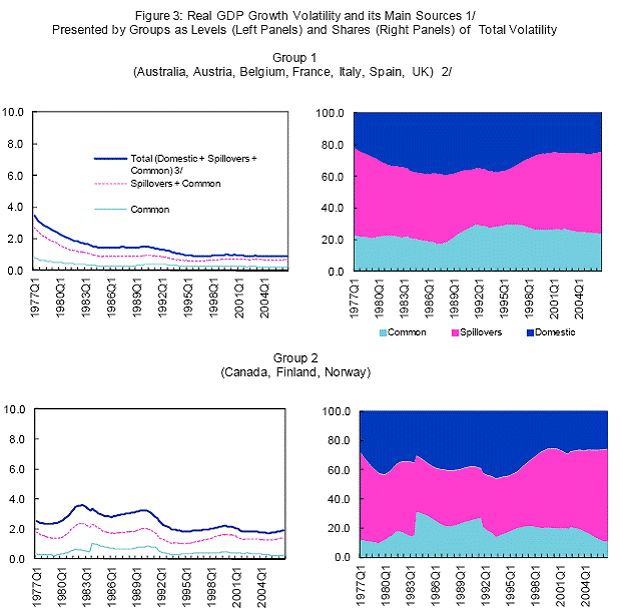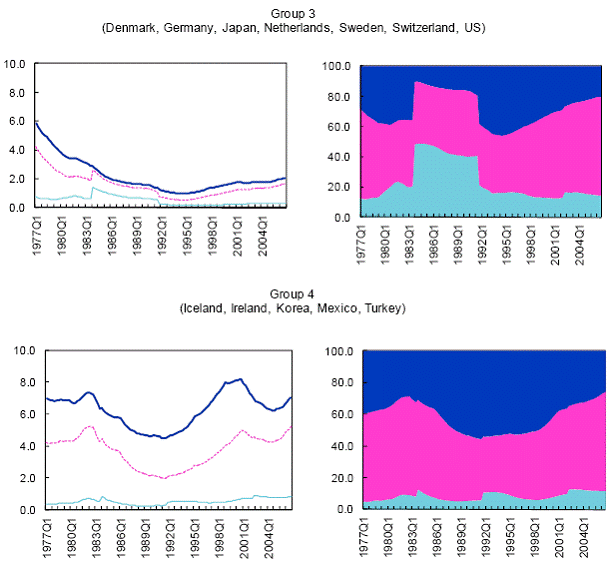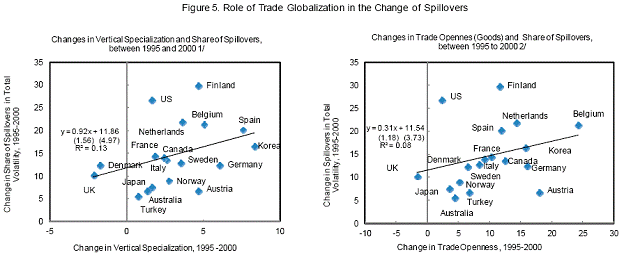In a post regarding the transmission of financial turmoil from Europe to the US last week, I noted my research with Kristin Forbes on the determinants of the strength of financial market linkages. A more recent and extensive survey of the macroeconomic — as opposed to financial — linkages is provided by a recent released working paper coauthored by Ashoka Mody and Alina Carare at the IMF.
The paper has three main findings. First, the reduction in output volatility apparently ceased
in some advanced industrialized countries by the mid-1990s, and a mild tendency towards
increased volatility was evident in some countries. Besides Japan (documented by Bernanke,
2004), one large country experiencing an increase in output growth volatility is Germany.
Second, and of greater significance for interpreting recent events, the bottoming out of the
decline in volatility and its possible reversal was associated with an increased role for
spillovers, starting sometime in the mid-1990s. Third, it was not the size of the spillover
“shocks” but rather the sensitivity of countries to these shocks that increased over time.
The evidence in this paper is consistent with the idea that improved domestic policies and
structural changes drove down the size of domestic shocks and hence aggregate volatility.
But potent though these forces were, the increasingly-interconnected nature of the global
economy introduced countervailing tendencies. As the global economy became more
integrated, shocks from one country were transmitted more rapidly and to more countries. In
the long expansion between 2001 and 2007, these linkages reinforced global growth.
However, the intensity of the recent crisis was in no small measure due to the speed at which
domestic shocks traveled across borders, amplifying the original shocks. Countries most
reliant on global financial and trade links were hardest hit.
Our paper is related to the literature on the comovement of business cycles (Kose, Otrok, and
Whiteman, 2005; and Kose, Otrok, and Prasad, 2008). In the cross-section, the higher a
country’s trade intensity, the higher is the comovement of its cycle with that of other
countries; however, an increase in global trade and finance intensities has not been
accompanied by an increase in business cycle comovement. This is not altogether surprising.
As Cecchetti, Flores-Lagunes, and Krause (2006) and Kose, Otrok, and Prasad (2008) note,
comovement will not increase if greater integration is primarily associated with increased
specialization. Hence, it is the nature of globalization that influences the changes in the
degree of comovement. Our analysis suggests that in the early to mid-1990s, the tendency
towards greater country alignment through rapid spillovers was associated with a particular
form of trade integration, namely, an acceleration of vertical specialization. By linking
countries in an international supply chain, such trade creates a tighter relationship between a
country’s exports and its imports, creating the conditions for swift production spillovers.
The authors use a two-factor structural FAVAR (Stock and Watson, 2005, [WP version]) to estimate the impact of the shocks. A decomposition of the volatility of GDP growth shocks yields the following graphs:


Notice that for Group 3, which includes the United States, spillover effects increase significantly over the sample period.
The authors point to increased vertical specialization as the cause of the increased rapidity of the transmission of macro shocks. The paper does not formally incorporate vertical specialization. Rather it shows that the correlation between spillovers and vertical specialization is higher than that with trade intensity.

This conclusion is consistent with the articles included in this CEPR VoxEU book on the recent trade collapse (discussed in this post). (For an instance where business cycle coherence is linked to trade intensity, see Chinn (2005).
This suggests that in predicting which countries will be most affected by any slowdown in, for instance, Euro Area GDP growth, one should pay most attention to the extent to which a given country is interlinked in the production chain.
One observation: one of the trends over the 1990s has been increasing trade globalization, as transportation costs have fallen. But with increasing fuel costs [1] [2] — and possibly increased protectionism [3] — it’s conceivable that the increasing fragmentation of production could be reversed over time. If that occurs, then vertical-specialization-induced spillovers could weaken over time. However, there is little evidence thus far that vertical specialization has reversed since the Great Recession.
We just had the biggest asset bubble in the history of the world. We are now experiencing the biggest fiscal and monetary stimulus (borrowing and printing) in the history of the world.
Somehow I don’t think the study of past mild business cycles will be instructive.
The spillover effects work in both directions. While the US economy imploded, China kept growing and seems to have blunted the effets of the recession on resource-weighted economies if not the larger global economy.
Increased international trade, in particular the so-called practice of ‘outsourcing’, has reduced market power of firms and workers and has helped tame inflationary expectations. The resulting low, stable inflation expectations gives fiscal and monetary policy makers more flexibility. Probably gives them more room to make bigger errors too.